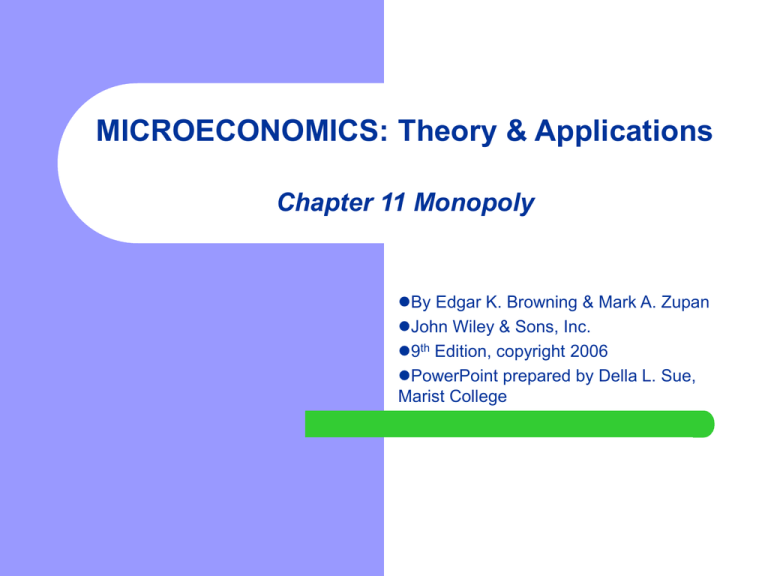
MICROECONOMICS: Theory & Applications
Chapter 11 Monopoly
By Edgar K. Browning & Mark A. Zupan
John Wiley & Sons, Inc.
9th Edition, copyright 2006
PowerPoint prepared by Della L. Sue,
Marist College
Learning Objectives
11-2
Define monopoly and show what a monopolist’s
demand and marginal revenue curves look like.
Explain why a monopolist’s profit-maximizing output
is where marginal revenue equals marginal cost.
Describe why the extent to which a monopolist’s price
exceeds marginal cost is larger the more inelastic the
demand faced by the monopolist.
(Continued)
John Wiley & Sons, Inc.
Copyright 2006
Learning Objectives (continued)
11-3
Understand why the shutdown condition applies to
monopolies as well as to firms operating in a perfectly
competitive market.
Outline the potential sources of monopoly power:
absolute cost advantages, economies of scale,
product differentiation, and regulatory barriers.
Explore the efficiency effects of monopoly from a
static as well as a dynamic perspective.
Overview public policy toward monopoly.
John Wiley & Sons, Inc.
Copyright 2006
Terminology
Monopoly – a market with a single seller
Monopoly power – some ability to set price
above marginal cost
Price maker – a monopoly that supplies the
total market and can choose any price along
the market demand curve that it wants
11-4
John Wiley & Sons, Inc.
Copyright 2006
The Monopolist’s Demand Curve
and Total Revenue
[Figure 11.1]
11-5
John Wiley & Sons, Inc.
Copyright 2006
Profit-Maximizing Output of a
Monopoly
11-6
Marginal revenue is
always less than price
when the demand
curve slopes
downward.
Profit is maximized
where MR=MC.
Figure 11.2
John Wiley & Sons, Inc.
Copyright 2006
The Monopoly Price and Its
Relationship to Elasticity of Demand
P = MC/[1 – (1/η)]
The smaller the demand elasticity, the greater the
profit-maximizing price, relative to marginal
cost.
11-7
John Wiley & Sons, Inc.
Copyright 2006
Further Implications of Monopoly
Analysis
A monopoly has no supply curve.
A monopoly does not necessarily make
positive economic profit.
A monopoly’s demand curve is elastic where
marginal revenue is positive.
A profit-maximizing monopolist will always sell
at a price where demand is elastic.
11-8
John Wiley & Sons, Inc.
Copyright 2006
Monopoly and the Shutdown
Condition
11-9
John Wiley & Sons, Inc.
[Figure 11.5]
Copyright 2006
Monopoly Demand, Marginal Revenue,
and Total Revenue
[Figure 11.6]
11-10
John Wiley & Sons, Inc.
Copyright 2006
Measuring Monopoly Power
11-11
Lerner Index – a means of measuring a firm’s
monopoly power that takes the markup of price over
marginal cost expressed as a percentage of a
product’s price:
Lerner Index = (P – MC)/P
The Lerner index varies between zero and one.
The larger the Lerner index value, the greater a firm’s
monopoly power.
John Wiley & Sons, Inc.
Copyright 2006
Sources of Monopoly Power
What factors determine the extent to which a
firm has monopoly power?
– The elasticity of the market demand curve
If the market demand curve is perfectly elastic, any
individual supplier has no monopoly power.
– The elasticity of supply by other firms
The monopoly power of any one firm is more limited when
there is a greater number of rival firms.
11-12
John Wiley & Sons, Inc.
Copyright 2006
Barriers to Entry
Barrier to entry – any factor that limits the number of firms
operating in a market and thereby serves to promote monopoly
power
Categories:
– Absolute cost advantage
A situation in which an incumbent firm’s production cost (longrun average total cost) is lower than potential rivals’ production
costs at all relevant output levels
–
Economies of scale
A situation in which the long-run average total cost curve for all
firms slopes downward over the entire range of market output
Natural monopoly
(Continued)
11-13
John Wiley & Sons, Inc.
Copyright 2006
Barriers to Entry (continued)
–
–
Product differentiation
A means by which consumers may perceive the product
sold by an incumbent firm to be superior to that offered by
prospective rivals.
Regulatory barriers
Barriers to entry created by the government through vehicles
such as patents, copyrights, franchises, and licenses
11-14
John Wiley & Sons, Inc.
Copyright 2006
Strategic Behavior by Firms:
Incumbents and Potential Entrants
[Figure 11.8]
11-15
John Wiley & Sons, Inc.
Copyright 2006
The Efficiency Effects of Monopoly
[Figure 11.9]
11-16
John Wiley & Sons, Inc.
Copyright 2006
A Dynamic View of Monopoly and
Its Efficiency Implications
11-17
Static analysis – a form of
economic analysis that
looks at the efficiency of a
market at any one point in
time
Dynamic analysis – a form
of economic analysis that
looks, over time, at the
efficiency of a market
Figure 11.10
John Wiley & Sons, Inc.
Copyright 2006
Public Policy Toward Monopoly
Antitrust laws – a series of codes and
amendments intended to promote a
competitive market environment
3 major statutes:
– Sherman Act (1890)
– Clayton Act (1914)
– Federal Trade Commission Act (1914)
11-18
John Wiley & Sons, Inc.
Copyright 2006
Regulation of Price
11-19
Price ceiling –
eliminates the
monopolist’s reason for
restraining output
Figure 11.11
John Wiley & Sons, Inc.
Copyright 2006
Copyright 2006 John Wiley & Sons, Inc. All rights reserved.
Reproduction or translation of this work beyond that
permitted in section 117 of the 1976 United States Copyright
Act without express permission of the copyright owner is
unlawful. Request for further information should be
addressed to the Permissions Department, John Wiley &
Sons, Inc. The purchaser may make back-up copies for
his/her own use only and not for distribution or resale. The
Publisher assumes no responsibility for errors, omissions,
or damages caused by the use of these programs or from
the use of the information herein.
11-20
John Wiley & Sons, Inc.
Copyright 2006





